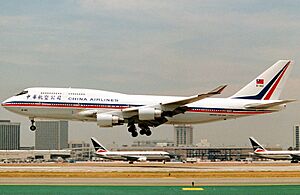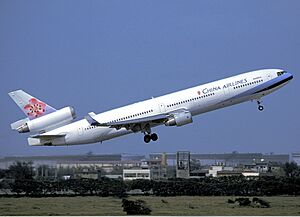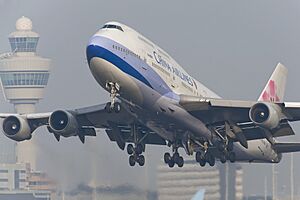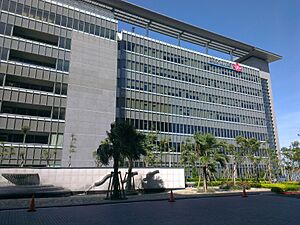China Airlines facts for kids
A China Airlines Airbus A350-900
|
|
| Founded | September 7, 1959 |
|---|---|
| Commenced operations | December 16, 1959 |
| Hubs | Taipei–Taoyuan |
| Focus cities |
|
| Frequent-flyer program | Dynasty Flyer |
| Alliance | SkyTeam |
| Subsidiaries |
|
| Fleet size | 86 |
| Destinations | 102 |
| Parent company | China Airlines Group |
| Headquarters | CAL Park, Dayuan District, Taoyuan City, Taiwan |
| Key people | |
| Revenue | |
| Operating income | |
| Net income | |
| Total assets | |
| Total equity | |
| Employees | 11,400 |
| China Airlines, Limited | |||||||||||||||||||||
|---|---|---|---|---|---|---|---|---|---|---|---|---|---|---|---|---|---|---|---|---|---|
| Traditional Chinese | 中華航空股份公司 | ||||||||||||||||||||
| Simplified Chinese | 中华航空股份公司 | ||||||||||||||||||||
|
|||||||||||||||||||||
| Abbreviation | |||||||||||||||||||||
| Traditional Chinese | 華航 | ||||||||||||||||||||
| Simplified Chinese | 华航 | ||||||||||||||||||||
|
|||||||||||||||||||||
China Airlines (often called CAL) is a big airline owned by the government of Taiwan. It's one of the three main airlines in Taiwan, along with EVA Air and Starlux Airlines. Its main office is near Taoyuan International Airport.
China Airlines flies over 1,400 times a week. This includes 91 flights just for cargo. They fly to 102 cities in Asia, Europe, North America, and Oceania. In 2017, they carried almost 20 million passengers and 5,700 tons of cargo. This made them one of the biggest airlines in the world for both passengers and cargo.
China Airlines is part of the China Airlines Group. This group also runs China Airlines Cargo, which is part of SkyTeam Cargo. China Airlines Cargo uses special planes to carry goods. The group also owns Mandarin Airlines, which flies shorter routes. Another airline in the group is Tigerair Taiwan, which offers cheaper flights. Tigerair Taiwan was started with a Singaporean airline group but is now fully owned by China Airlines Group.
Contents
The Story of China Airlines
Starting Up: The Early Years (1959-1970)
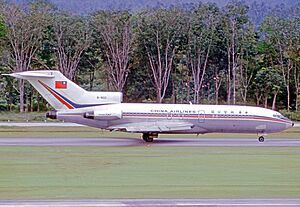
China Airlines started on December 16, 1959. It began with two PBY Amphibian planes. The government of Taiwan owned all its shares. It was founded by I Fuen, who used to be an officer in the ROC Air Force. At first, the airline mostly flew special charter flights.
In the 1960s, China Airlines began regular flights. In October 1962, its first domestic flight went from Taipei to Hualien. Soon after, they started international flights to places like South Vietnam, Hong Kong, and Japan. On February 2, 1970, they began flying across the Pacific Ocean to San Francisco. These flights stopped in Tokyo and used their first two Boeing 707 planes. More 707 planes helped them fly to more places in Asia and North America.
Flying Further: Growing Around the World (1970-1995)
China Airlines started using the large 747 planes in 1976. They used them for popular flights to the United States. Their first 747s flew from Hong Kong to Taipei, Tokyo, Honolulu, and Los Angeles. In 1977, they added four new 747SPs. These special planes allowed China Airlines to fly nonstop from Taipei to North America. They also started flights to Saudi Arabia and South Africa.
In 1979, the airline moved all its flights from the smaller Taipei Songshan Airport to the new Chiang Kai-Shek International Airport. This airport is now called Taoyuan International Airport. After getting more 747-200 planes, they started flying to their first European city, Amsterdam.
For a while, China Airlines was the only foreign airline using Haneda Airport in Japan. This was because airlines from Taiwan and mainland China were kept separate. Later, both China Airlines and EVA Air moved their flights to Narita International Airport.
The next 20 years saw the airline grow a lot. They even started a round-the-world flight. This route went from Taipei to Anchorage, New York, Amsterdam, Dubai, and back to Taipei.
In 1990, China Airlines received its first Boeing 747-400 plane. By 1993, the airline was listed on the Taiwan Stock Exchange. New 747-400s and Airbus planes like the A300B4 and A300-600R helped them add more destinations. In the 1990s, China Airlines also bought McDonnell Douglas MD-11 planes. They also faced competition from a new airline, EVA Air. They even started another airline, Mandarin Airlines, to help with flights related to the political situation between Taiwan and mainland China. One of their 747-400s was used by President Lee Tung-hui for a trip to the United States in 1995.
A New Look: Plum Blossoms and Safety (1995-2010)
As Taiwan's main airline, China Airlines was affected by political issues. Some countries that had ties with mainland China did not allow China Airlines to fly there. To help with this, in the mid-1990s, their sister airline Mandarin Airlines took over some international flights to Sydney and Vancouver.
Starting in October 1995, China Airlines changed its logo to a "plum blossom" flower. This replaced the Taiwanese flag that used to be on the tail of their planes. The plum blossom is Taiwan's national flower. This change was partly to avoid political problems and help the airline fly to more places.
In the 1990s, China Airlines hired many pilots who used to be in the air force. Because of some safety problems in the 1990s, China Airlines changed how it hired pilots. They started looking for pilots who had already proven their skills. They also began training university graduates to become pilots. The airline also improved its maintenance and how it ran flights. These changes helped the airline become much safer. They even received a special safety award from IATA.
During the 1990s and early 2000s, China Airlines ordered new planes like the Airbus A330, Airbus A340, Boeing 737-800, and more 747-400s.
As relations between Taiwan and mainland China improved, the first special flights between them started in 2003. China Airlines flight 585 was the first Taiwanese flight to land legally in mainland China. In 2005, the first nonstop flights between Taiwan and mainland China began. By 2009, regular scheduled flights were finally allowed.
On September 14, 2010, China Airlines agreed to join the SkyTeam airline group. They officially became a full member on September 28, 2011. This led to a new logo and a new way the "China Airlines" name was written on planes. It was the first airline from Taiwan to join a major airline group.
Modern Times: New Planes and Projects (2012-Today)
Since 2012, China Airlines has helped with a project to measure greenhouse gases. They put special equipment on three of their planes. These planes collected data on greenhouse gases during their flights. One of these planes even had a special design that said "The Official Airline for Climate Monitoring."
In December 2013, China Airlines announced a new partnership with a Singaporean airline group. They created Tigerair Taiwan, a new low-cost airline. Tigerair Taiwan started flying in September 2014. It was the first low-cost airline from Taiwan. China Airlines Group now fully owns Tigerair Taiwan.
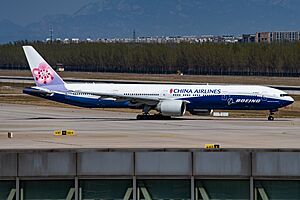
In March 2014, China Airlines announced its "NexGen" plan. This plan was to update the airline's image and services. It included new products, new uniforms, and replacing older planes. They worked with designers to show off Taiwan's culture. The first part of the plan brought new cabin designs and updated lounges at Taiwan Taoyuan International Airport. They also introduced new uniforms designed by William Chang. The new planes allowed them to stop using older aircraft. For example, all their A340-300 planes were retired by June 2017. They also stopped offering First Class service in 2016. First Class seats are now sold as Business Class.
Future parts of the NexGen plan include ordering new planes. In May 2019, the airline announced they would get Airbus A321neo planes. These will replace their Boeing 737-800 planes. They also ordered Boeing 777F cargo planes to replace their Boeing 747-400F cargo planes. The new A321neo planes will have a similar design inside to the 777 and A350 planes.
China Airlines is also focusing on plane maintenance and repair. In January 2015, they started Taiwan Aircraft Maintenance & Engineering Co. (TAMECO). This company fixes and maintains planes. Airbus is helping them with this project. They also partnered with Nordam, a company that specializes in certain plane parts. The first TAMECO hangar was finished in March 2019. It can hold several large planes at once.
There have been some worker disagreements at China Airlines recently. In June 2016, flight attendants went on strike for a day. This was the first airline strike in Taiwan's history. In 2019, over 600 pilots went on strike for seven days. Many flights were canceled during these strikes.
In July 2020, the government suggested changing the airline's name. This was because people sometimes confused China Airlines with Air China. However, the name change plans were put on hold in 2022.
Where China Airlines Calls Home
China Airlines has its main office, called CAL Park, at Taiwan Taoyuan International Airport. CAL Park is located right at the airport entrance. It lines up with Terminal 1, Terminal 2, and the future Terminal 3.
Before, China Airlines had offices in different places. They had a main office in Taipei and other facilities at the airport. All these offices were brought together after CAL Park was finished. A smaller office for the airline still remains in downtown Taipei.
What Makes China Airlines Special?
Plane Designs and Uniforms
Before 1995, China Airlines planes had the Taiwanese flag on their tails. This was common for companies related to Taiwan after 1949. In the 1990s, the airline changed its logo to a plum blossom flower. This was reportedly done so the airline could keep flying to Hong Kong after 1997. The plum blossom is Taiwan's national flower.
In 2011, the airline updated its logo again. This was part of joining the SkyTeam group. They chose a new font for the company name. The plum blossom logo also got a fresh look.
China Airlines has had many different uniforms since 1959. The current uniform was designed by William Chang. It was introduced in 2015 as part of the "NexGen" plan.
Catchy Slogans
China Airlines has used different slogans over the years. In 2006, they introduced their current slogan. This slogan came out with new uniforms and celebrated their 47th birthday. Here are some of their past slogans:
- We treasure every encounter (1987–1995)
- We blossom everyday (1995–2006)
- Journey with a caring smile (2006)
- Expect The Coming Greatness (around 2016)
Why the Name Matters
The name China Airlines comes from Taiwan's official name, the Republic of China. This caused some confusion during the COVID-19 pandemic. People sometimes thought China Airlines flights were from mainland China, not Taiwan. In April 2020, the Premier of Taiwan supported changing the name. However, he said it might affect the airline's flight rights. The Premier announced that China Airlines would add "Taiwan" to the side of planes carrying medical supplies.
Cool Plane Designs!
China Airlines has many special plane designs. The first one, "Taiwan Touch Your Heart," came out in 2003. It was to promote tourism in Taiwan. Currently, China Airlines has 9 special planes flying.
Planes with special co-branded designs:
- B-18007 (Boeing 777-300ER) – The first Boeing 777 with a co-branded design.
- B-18918 (Airbus A350-900) – The first Airbus A350 with a co-branded design.
A plane that used to have a co-branded design:
- B-18210 (Boeing 747-400) – Called 'Blue Whale'; it was the first Boeing 747-400 with a Boeing co-branded design.
"Taiwan's Flying Ambassadors" Planes
In 2016, China Airlines announced a special theme for its Airbus A350-900 planes. Each plane would be named after a special bird or feature of Taiwan. The first two A350s were named after the Mikado pheasant and the Taiwan blue magpie. The public helped choose the names for the other 12 planes.
Planes in this series:
- B-18901 (Airbus A350-900) – Named and designed after the Mikado pheasant.
- B-18908 (Airbus A350-900) – Named and designed after the Taiwan blue magpie.
SkyTeam Alliance Planes
China Airlines has two planes painted with the SkyTeam alliance design:
- B-18311 (Airbus A330-300) – This plane used to have the "Sweet Fruit" design.
Planes that used to be part of this series:
- B-18206 (Boeing 747-400) – The first Boeing 747 to have the SkyTeam design.
- B-18211 (Boeing 747-400)
The Pokémon Jet!
China Airlines launched the first Pokémon Jet in Taiwan. This was part of "Pokémon Air Adventures," a project with The Pokémon Company. The plane is an Airbus A321neo called "Pikachu Jet CI." It features Pikachu and other popular Pokémon. The jet also has Pokémon-themed tickets, items on the plane, and merchandise.
Planes in this series:
- B-18101 (Airbus A321neo) – Features Pikachu, Shaymin, Swablu, Togekiss, Munna, Jigglypuff, Snorlax, Slowpoke, and Teddiursa.
Past Special Plane Designs
50th Birthday Planes
In 2009, China Airlines celebrated its 50th birthday. They decorated one plane of each type with a "50th Anniversary" logo. All these planes now have the regular airline design or another special design.
Celebrating Taiwan's Culture
In 2013, China Airlines planned a series of planes with Taiwan-themed designs. They worked with Taiwanese artists and the Tourism Bureau to create these special designs.
60th Birthday Planes
In 2019, China Airlines reached 60 years of flying. To celebrate, they put special "60th Anniversary" stickers on one plane from each type of their fleet. The logo looked like the number "60" and also like "GO" and the infinity symbol. All these planes now have the regular airline design.
Where Do They Fly?
China Airlines flies over 1,400 times a week. This includes cargo flights. They fly to 178 airports in 29 countries across 4 continents. Japan is their most important market. They have over 180 flights each week from Taiwan to 14 Japanese cities.
China Airlines' biggest hub is Taoyuan International Airport. This is Taiwan's largest airport, near the capital city of Taipei. China Airlines uses both Terminal 1 and Terminal 2 at this airport. Flights to Europe, India, Korea, Hong Kong, and Southeast Asia use Terminal 1. Flights to mainland China, Japan, North America, and Oceania use Terminal 2.
China Airlines also has many flights from Kaohsiung International Airport and Taipei Songshan Airport. Flights from Songshan Airport to downtown airports in Tokyo, Seoul, and Shanghai are very important. They form a "Northeast Asia Golden Flight Circle."
For a long time, China Airlines' international growth was limited by Taiwan's political situation. Flights to mainland China were not allowed until 2003. China Airlines flight 585 was the first Taiwanese plane to legally land in mainland China. This was the first legal flight between the two areas since the Chinese Civil War. The airline flew occasional special flights for a few more years. Regular flights started in 2008. In 2009, a new agreement allowed China Airlines to start regular flights to mainland China. Since then, mainland China has become China Airlines' second-largest market. They have over 130 flights to 33 cities there.
In September 2022, China Airlines announced they would restart flights to Bali. This popular tourist spot in Indonesia was recovering from the COVID-19 pandemic.
Future Flight Plans
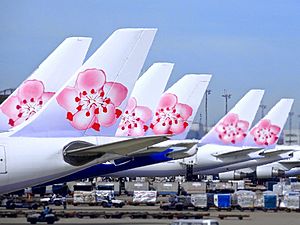
Between 2011 and 2015, China Airlines focused on making its regional network stronger. From 2015 to 2020, they worked on expanding their flights to Europe, North America, and Oceania. They used new long-haul planes for this. After making all their European routes nonstop, they started four weekly flights to London Gatwick Airport in late 2017. However, due to the COVID-19 pandemic, flights to London were moved to Heathrow Airport. China Airlines decided to keep flying to Heathrow.
For France, China Airlines cannot fly directly to Paris. So, they partnered with SkyTeam airline Air France. They launched nonstop flights to Paris on Air France planes in April 2018. China Airlines sells 40% of the seats on these flights. In July 2023, they started flying twice a week to Prague. In America, daily flights started between Taipei and Ontario (California) International Airport in March 2018.
China Airlines is also interested in flying to other European cities. These include Barcelona, Madrid, and Warsaw. In North America, they are looking at Atlanta, Boston, Chicago, Seattle, Montréal, and Toronto.
For their regional flights, China Airlines is supporting Taiwan's "New Southbound Policy." This means they are increasing flights to Southeast Asia. On the other hand, flights to mainland China are being reduced due to political tensions.
Working with Other Airlines (Interline)
China Airlines has agreements with these airlines to help passengers connect flights:
China Airlines shares flights with these airline partners:
- Air Europa
- Air France
- Bangkok Airways
- British Airways
- China Eastern Airlines
- China Southern Airlines
- Delta Air Lines
- Garuda Indonesia
- ITA Airways
- Japan Airlines
- J-Air
- KLM
- Korean Air
- Mandarin Airlines (their sister airline)
- Malaysia Airlines
- Philippine Airlines
- Qantas
- Royal Brunei Airlines
- Scandinavian Airlines
- Shanghai Airlines
- Vietnam Airlines
- WestJet
- XiamenAir
Deutsche Bahn (DB), a German train company, is also a partner. China Airlines uses its code on seven train routes from Frankfurt. These routes go to cities like Cologne, Düsseldorf, and Munich. China Airlines is also planning to share flights with British Airways.
The China Airlines Fleet
Planes Flying Today
As of July 2025, China Airlines uses these planes:
| Aircraft | In service | Orders | Passengers | Notes | ||||
|---|---|---|---|---|---|---|---|---|
| C+ | C | W | Y | Total | ||||
| Airbus A321neo | 17 | 19 | — | 12 | — | 168 | 180 | 17 planes are leased, 11 are bought, with 5 more as options. They are replacing Boeing 737-800 planes. |
| Airbus A330-300 | 16 | — | — | 36 | — | 277 | 313 | These planes will be replaced by Boeing 787 planes. |
| 30 | 307 | |||||||
| Airbus A350-900 | 15 | 5 | — | 32 | 31 | 243 | 306 | One leased plane arrived in January 2024. Airbus will update the inside of all 15 planes. |
| 40 | 32 | 228 | 300 | |||||
| Airbus A350-1000 | — | 10 | TBA | 10 planes ordered with 5 more as options. They will replace Boeing 777-300ER planes. |
||||
| Boeing 737-800 | 10 | — | — | 8 | — | 150 | 158 | These planes will be replaced by Airbus A321neo planes. |
| 153 | 161 | |||||||
| Boeing 777-300ER | 10 | — | — | 40 | 62 | 256 | 358 | These planes will be replaced by Airbus A350-1000 and Boeing 777-9 planes. |
| Boeing 777-9 | — | 10 | TBA | 10 planes ordered with 5 more as options. They will replace Boeing 777-300ER planes. |
||||
| Boeing 787-9 | — | 18 | TBA | 16 787-9s were originally ordered with 8 options. 6 787-9s were changed to 787-10s. They will replace Airbus A330-300 planes. |
||||
| Boeing 787-10 | — | 6 | TBA | |||||
| China Airlines Cargo fleet | ||||||||
| Boeing 747-400F | 8 | — | Cargo | These planes will be replaced by Boeing 777-8F planes. | ||||
| Boeing 777F | 10 | — | Cargo | |||||
| Boeing 777-8F | — | 4 | Cargo | 4 planes ordered with 4 more as options. They will replace Boeing 747-400F planes. |
||||
| Total | 86 | 72 | ||||||
Planes They Used to Fly
China Airlines has used many different types of planes over the years. Here are some of the planes they no longer fly:
| Aircraft | Number of planes | Started using | Retired | Replaced by | Notes |
|---|---|---|---|---|---|
| Airbus A300B4-200 | 6 | 1985 | 2001 | Airbus A300-600R | |
| Airbus A300-600R | 10 | 1987 | 2007 | Airbus A330-300 | |
| 1 | 1994 | None | Crashed as flight CI140. | ||
| 1 | 1998 | Crashed as flight CI676. | |||
| Airbus A320-200 | 2 | 1994 | 1997 | None | |
| Airbus A340-300 | 7 | 2001 | 2017 | Airbus A350-900 | |
| Boeing 707-320 | 6 | 1969 | 1985 | Boeing 747-200B | |
| Boeing 727-100 | 4 | 1967 | 1982 | Boeing 737-200 | |
| Boeing 737-200 | 5 | 1976 | 1996 | Boeing 737-400 | |
| 1 | 1986 | None | Crashed as flight CI2265. | ||
| 1 | 1989 | Crashed as flight CI204. | |||
| Boeing 737-400 | 6 | 1996 | 1999 | Boeing 737-800 | |
| Boeing 747-100 | 2 | 1975 | 1984 | Boeing 747-200B | |
| Boeing 747-200B | 3 | 1978 | 1997 | Boeing 747-400 | Changed to cargo plane and moved to China Airlines Cargo. |
| 1 | 2002 | None | Crashed as flight CI611. | ||
| Boeing 747-200F | 2 | 1980 | 2003 | Boeing 747-400F | |
| 1 | 1991 | None | Crashed as flight CI358. | ||
| Boeing 747-200SF | 7 | 1992 | 2002 | Boeing 747-400F | |
| Boeing 747SP | 4 | 1977 | 1999 | Airbus A340-300 | |
| Boeing 747-400 | 19 | 1990 | 2021 | Airbus A350-900 Boeing 777-300ER |
Includes the very last passenger Boeing 747-400 ever built. |
| 1 | 1993 | None | Damaged beyond repair as flight CI605. | ||
| Boeing 767-200 | 2 | 1983 | 1989 | None | |
| Consolidated PBY Catalina | 2 | 1959 | 1966 | None | |
| Douglas DC-3 | 9 | 1959 | 1976 | Boeing 737-200 | |
| Douglas DC-4 | Unknown | 1962 | 1975 | Boeing 737-200 | |
| McDonnell Douglas MD-11 | 3 | 1992 | 2001 | Airbus A340-300 | |
| 1 | 1992 | 1999 | None | Crashed as flight CI642. | |
| NAMC YS-11 | 1 | 1970 | 1979 | Boeing 737-200 | |
| 1 | 1970 | None | Crashed as flight CI206. | ||
| Sud Aviation Caravelle | 3 | 1970 | 1980 | Unknown | |
| 1 | 1971 | None | Crashed as flight CI825. |
Plane Updates and Future Plans
In May 2019, China Airlines announced they would get Airbus A321neo planes. These will replace their Boeing 737-800 fleet. They will receive 25 A321neos, with 14 leased and 11 bought. Deliveries started in 2021. They also have an option to buy five more.
China Airlines also has options for six more A350 planes. They will decide whether to buy these based on how well the planes perform on nonstop flights to Europe. They are being careful about ordering the larger A350-1000 because it has a very big capacity.
For the Airbus A330-300 planes, plans to replace them started in 2017. In 2016, they had planned to update the inside of the A330s. But this plan was stopped to focus on getting new planes. On August 30, 2022, the airline decided to order Boeing 787-9 planes to replace the A330-300s. On September 29, 2022, China Airlines officially ordered 16 Boeing 787-9 planes. On December 19, 2024, the airline announced plans to order 10 Boeing 777-9s and 10 Airbus A350-1000s. These will add to and update their long-haul fleet. The A350-1000 order was finalized on March 31, 2025, and the Boeing 777-9 order was finalized on May 8, 2025.
Retiring Older Planes
In June 2017, China Airlines finished retiring all its Airbus A340-300 planes. They also retired most of their Boeing 747-400 planes delivered before 2004. Most of the Boeing 737-800 planes delivered before 2014 have also been phased out. The retired A340-300 and Boeing 747-400 planes are either stored or sold. The last of the newer Boeing 747-400 passenger planes were retired in March 2021.
Cargo Plane Plans
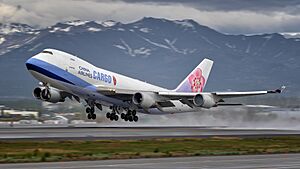
China Airlines Cargo is the part of China Airlines that carries freight. It has 21 cargo planes. They fly to 33 cities in Asia, Europe, and North America. They also use the cargo space on the passenger planes. In May 2019, China Airlines signed an agreement to buy three Boeing 777F cargo planes, with options for three more. These 3 options were later changed to firm orders. The 777F planes will partly replace the 747-400F fleet. In January 2022, they ordered four more 777F planes. In August 2022, the airline said they are looking at Airbus A350F and Boeing 777-8F planes to replace the rest of their 747-400F fleet. On December 19, 2024, the airline announced plans to order 4 Boeing 777-8Fs. This order was finalized on May 8, 2025.
Services for Passengers
Dynasty Flyer Program
Dynasty Flyer is China Airlines' program for frequent flyers. It has four levels: Gold, Emerald, and Paragon are the elite levels. Members can reach these levels by earning enough flight miles or segments within 12 months. Elite members get special benefits. These include access to VIP Lounges, more baggage allowance, and being able to upgrade their tickets.
Greater China Connection
In January 2013, China Airlines and other SkyTeam airlines announced a plan called Greater China Connection. These airlines include China Eastern Airlines, China Southern Airlines, and XiamenAir. This partnership means members flying these four airlines get similar benefits. They can also easily change flights to any partner airline.
Dynasty Lounges
China Airlines has special waiting areas at airports called "Dynasty Lounge." There are nine of these lounges, including one for Mandarin Airlines in Taichung. At other airports, China Airlines passengers can use lounges run by SkyTeam, partner airlines, or local companies.
Dynasty Lounges are for Business Class passengers and Dynasty Flyer Gold, Emerald, and Paragon members. Lounges with two sections have an "Exclusive Area" for Emerald and Paragon members. The "Business Class Area" is for Business Class passengers and Gold members.
What you find in a Dynasty Lounge can be different depending on the location. Usually, they offer meals, drinks, free Wi-Fi, computers, TVs, magazines, showers, and rooms for nursing mothers. The newly updated lounge at Taiwan Taoyuan International Airport Terminal 1 has sleeping areas and tea bars.
Dynasty Lounge locations:
- Taipei Taoyuan International Airport Terminal 1
- Taipei Taoyuan International Airport Terminal 2 (near Gate D4)
- Taipei Taoyuan International Airport Terminal 2 (used to be called Dynasty Supreme Lounge)
- Kaohsiung International Airport
- Kuala Lumpur International Airport
- Bangkok Suvarnabhumi Airport
- Tokyo Narita International Airport Terminal 2
- Honolulu International Airport
- San Francisco International Airport
SkyTeam Lounge Hong Kong
At Hong Kong International Airport Terminal 1, China Airlines uses the SkyTeam alliance lounge. China Airlines, China Eastern Airlines, and Plaza Premium Lounge helped design and manage this lounge. It is 1,038 square meters and has 230 seats.
Private Bus Services in the United States
In the United States, China Airlines offers private bus services in some cities. These buses take customers between their homes and the airport.
In the Greater New York area, a bus goes to John F. Kennedy International Airport. It picks up passengers from places like Fort Lee, Parsippany-Troy Hills, and Edison in New Jersey. It also serves several spots in Greater Philadelphia. In Los Angeles, a bus takes customers between Los Angeles International Airport, Monterey Park, and Rowland Heights.
The airline used to have buses in San Francisco, Houston, and Abu Dhabi.
Other Companies in the China Airlines Group
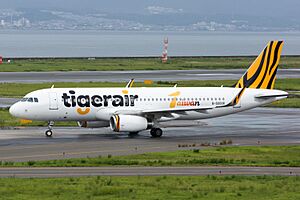
China Airlines has grown into other related businesses. These include handling planes on the ground, aviation engineering, and making food for flights.
In 2022, China Airlines opened a big plane maintenance and repair center at Taoyuan International Airport. This was a joint project with Nordam.
Here are some companies that the China Airlines Group owns or has a big part in:
| Company | Type | Main activities | Location | Group's ownership |
|---|---|---|---|---|
| Cal-Asia Investment Inc. | Subsidiary | Holding company | British Virgin Islands | 100% |
| CAL Park | Subsidiary | Headquarters | Taiwan | 100% |
| China Aircraft Services Limited | Joint Venture | Maintenance Company | Hong Kong | 20% |
| China Pacific Catering Services Limited | Subsidiary | Catering services | Taiwan | 51% |
| China Pacific Laundry Services Limited | Subsidiary | Laundry | Taiwan | 55% |
| Dynasty Holidays | Subsidiary | Travel agency | Taiwan | 51% |
| Global Sky Express Limited | Joint Venture | Cargo loading | Taiwan | 25% |
| Hwa Hsia Company Limited | Subsidiary | Laundry | Taiwan | 100% |
| Mandarin Airlines | Subsidiary | Regional airline | Taiwan | 93.99% |
| Taiwan Air Cargo Terminals Limited | Subsidiary | Cargo loading | Taiwan | 54% |
| Taiwan Aircraft Maintenance & Engineering Co. (TAMECO) | Subsidiary | MRO company | Taiwan | 100% |
| Taoyuan International Airport Services Limited | Subsidiary | Ground handling | Taiwan | 49% |
| Tigerair Taiwan | Subsidiary | Low-cost carrier | Taiwan | 100% |
Images for kids
-
China Airlines Airbus A300-B4
-
China Airlines Airbus A300-600R
-
China Airlines Airbus A330-300 with Rolls-Royce Trent 700 engines (leased from Virgin Atlantic)
-
China Airlines Airbus A340-300
-
China Airlines Boeing 707
-
China Airlines Boeing 747-200 SF
-
China Airlines Boeing 747SP
-
China Airlines Boeing 767-200
-
China Airlines Boeing 747-400
-
China Airlines Boeing 737-800
-
China Airlines Boeing 747-400F
See also
 In Spanish: China Airlines para niños
In Spanish: China Airlines para niños


